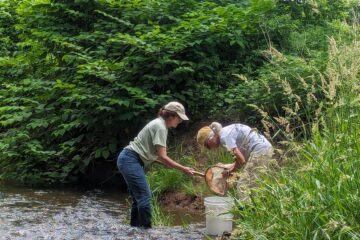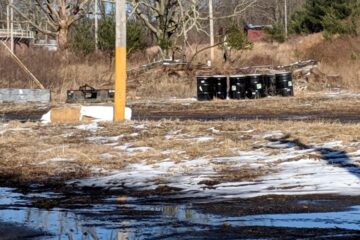This summer and fall, you may have noticed a pretty, dusky-colored spotted insect whose wings open to reveal brilliant scarlet underwings. You may have thought it was a type of moth.
Don’t be fooled … this beauty is actually a beast! It’s a spotted lanternfly, an invasive insect that threatens our forests, orchards and vineyards.
The help of local residents is desperately needed this fall and winter to bring what has become an infestation in our area under control!
Spotted lanternflies aren’t flies at all, but a planthopper that feeds off the sap of trees and vines. Native to Asia, they were accidentally introduced in Pennsylvania in 2014 and have been rapidly spreading ever since. They’re now found in eight western New Jersey counties, including much of the upper Raritan River watershed.
With few natural predators, spotted lanternflies reproduce quickly and prolifically. Their favorite food is the tree-of-heaven (Ailanthus altissima), also native to Asia and considered a local invasive. But in the absence of Ailanthus, lanternflies will suck the sap of fruit trees, grapevines and native trees in New Jersey’s forests, weakening and potentially killing them. Many local infestations were discovered this past summer.
Here’s what you can do to help:
- Learn to identify spotted lanternflies in their various life stages, and kill them when you find them. It’s easy if there are just a few individuals, but if there’s an infestation it will be necessary to trap and treat them. None of us enjoy killing things, but this pest can damage native trees if left unchecked.
- Learn to identify lanternfly egg cases and destroy them. Egg cases are grayish-brown and can resemble splotches of mud. They may be found in a variety of locations, including tree trunks, cement, wood, and metal surfaces. Adult lanternflies don’t survive the winter, so finding and destroying their egg cases is key to preventing a hatch next spring.
- If you see spotted lanternflies in Morris County, please email a report of your sightings to the NJ Department of Agriculture at slf-plantindustry@ag.nj.gov or call 609-406-6943. Lanternflies are more pervasive in Hunterdon and Somerset counties, and reporting is not necessary.
- Learn how to distinguish lanternflies’ preferred host, tree-of-heaven, from similar looking native trees like sumac and black walnut. But simply cutting Ailanthus trees down won’t help control lanternflies, because many more individual trees will sprout from their roots. Learn the correct techniques for eradicating tree-of-heaven, but also be aware that if you have a large lanternfly infestation you should consider leaving a couple of “trap trees” on your property to attract the majority of spotted lanternflies so they can be treated.
To learn more about spotted lanternflies and how you can help stop their spread here, where you will find photos of lanternflies in their various life stages and many helpful links.
Thank you! By becoming aware of this threat and taking action, all of us in the upper Raritan River watershed can help the trees that, in turn, are critical to protecting our local water quality.



